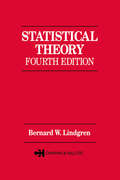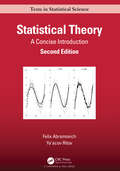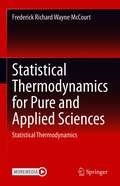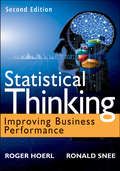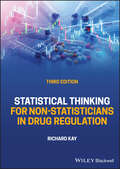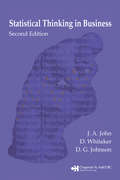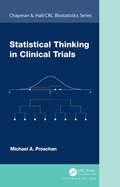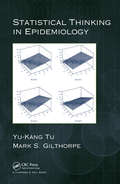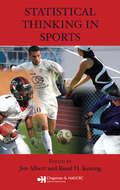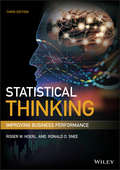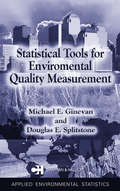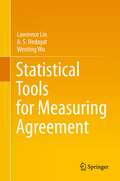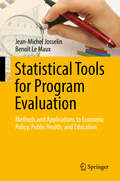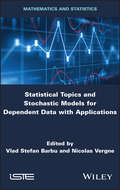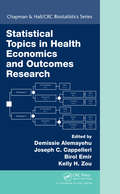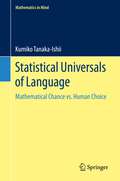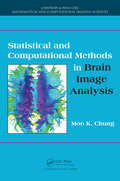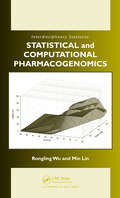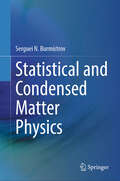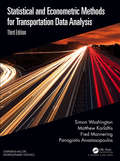- Table View
- List View
Statistical Test Theory for the Behavioral Sciences (Chapman & Hall/CRC Statistics in the Social and Behavioral Sciences)
by Dato N. de Gruijter Leo J. van der KampSince the development of the first intelligence test in the early 20th century, educational and psychological tests have become important measurement techniques to quantify human behavior. Focusing on this ubiquitous yet fruitful area of research, Statistical Test Theoryfor the Behavioral Sciences provides both a broad overview and a
Statistical Testing Strategies in the Health Sciences (Chapman & Hall/CRC Biostatistics Series)
by Albert Vexler Alan D. Hutson Xiwei ChenStatistical Testing Strategies in the Health Sciences provides a compendium of statistical approaches for decision making, ranging from graphical methods and classical procedures through computationally intensive bootstrap strategies to advanced empirical likelihood techniques. It bridges the gap between theoretical statistical methods and practical procedures applied to the planning and analysis of health-related experiments. The book is organized primarily based on the type of questions to be answered by inference procedures or according to the general type of mathematical derivation. It establishes the theoretical framework for each method, with a substantial amount of chapter notes included for additional reference. It then focuses on the practical application for each concept, providing real-world examples that can be easily implemented using corresponding statistical software code in R and SAS. The book also explains the basic elements and methods for constructing correct and powerful statistical decision-making processes to be adapted for complex statistical applications. With techniques spanning robust statistical methods to more computationally intensive approaches, this book shows how to apply correct and efficient testing mechanisms to various problems encountered in medical and epidemiological studies, including clinical trials. Theoretical statisticians, medical researchers, and other practitioners in epidemiology and clinical research will appreciate the book’s novel theoretical and applied results. The book is also suitable for graduate students in biostatistics, epidemiology, health-related sciences, and areas pertaining to formal decision-making mechanisms.
Statistical Theory (Chapman And Hall/crc Texts In Statistical Science Ser. #22)
by Bernard LindgrenThis classic textbook is suitable for a first course in the theory of statistics for students with a background in calculus, multivariate calculus, and the elements of matrix algebra.
Statistical Theory: A Concise Introduction (Chapman & Hall/CRC Texts in Statistical Science #100)
by Felix Abramovich Ya'acov RitovDesigned for a one-semester advanced undergraduate or graduate statistical theory course, Statistical Theory: A Concise Introduction, Second Edition clearly explains the underlying ideas, mathematics, and principles of major statistical concepts, including parameter estimation, confidence intervals, hypothesis testing, asymptotic analysis, Bayesian inference, linear models, nonparametric statistics, and elements of decision theory. It introduces these topics on a clear intuitive level using illustrative examples in addition to the formal definitions, theorems, and proofs. Based on the authors’ lecture notes, the book is self-contained, which maintains a proper balance between the clarity and rigor of exposition. In a few cases, the authors present a "sketched" version of a proof, explaining its main ideas rather than giving detailed technical mathematical and probabilistic arguments. Features: Second edition has been updated with a new chapter on Nonparametric Estimation; a significant update to the chapter on Statistical Decision Theory; and other updates throughout No requirement for heavy calculus, and simple questions throughout the text help students check their understanding of the material Each chapter also includes a set of exercises that range in level of difficulty Self-contained, and can be used by the students to understand the theory Chapters and sections marked by asterisks contain more advanced topics and may be omitted Special chapters on linear models and nonparametric statistics show how the main theoretical concepts can be applied to well-known and frequently used statistical tools The primary audience for the book is students who want to understand the theoretical basis of mathematical statistics—either advanced undergraduate or graduate students. It will also be an excellent reference for researchers from statistics and other quantitative disciplines.
Statistical Thermodynamics and Stochastic Kinetics
by Yiannis N. KaznessisPresenting the key principles of thermodynamics from a microscopic point of view, this book provides engineers with the knowledge they need to apply thermodynamics and solve engineering challenges at the molecular level. It clearly explains the concepts of entropy and free energy, emphasizing key ideas used in equilibrium applications, whilst stochastic processes, such as stochastic reaction kinetics, are also covered. It provides a classical microscopic interpretation of thermodynamic properties, which is key for engineers, rather than focusing on more esoteric concepts of statistical mechanics and quantum mechanics. Coverage of molecular dynamics and Monte Carlo simulations as natural extensions of the theoretical treatment of statistical thermodynamics is also included, teaching readers how to use computer simulations and thus enabling them to understand and engineer the microcosm. Featuring many worked examples and over 100 end-of-chapter exercises, it is ideal for use in the classroom as well as for self-study.
Statistical Thermodynamics and Stochastic Kinetics
by Yiannis N. KaznessisPresenting the key principles of thermodynamics from a microscopic point of view, this book provides engineers with the knowledge they need to apply thermodynamics and solve engineering challenges at the molecular level. It clearly explains the concepts of entropy and free energy, emphasizing key ideas used in equilibrium applications, whilst stochastic processes, such as stochastic reaction kinetics, are also covered. It provides a classical microscopic interpretation of thermodynamic properties, which is key for engineers, rather than focusing on more esoteric concepts of statistical mechanics and quantum mechanics. Coverage of molecular dynamics and Monte Carlo simulations as natural extensions of the theoretical treatment of statistical thermodynamics is also included, teaching readers how to use computer simulations and thus enabling them to understand and engineer the microcosm. Featuring many worked examples and over 100 end-of-chapter exercises, it is ideal for use in the classroom as well as for self-study.
Statistical Thermodynamics for Pure and Applied Sciences: Statistical Thermodynamics
by Frederick Richard McCourtThis textbook concerns thermal properties of bulk matter and is aimed at advanced undergraduate or first-year graduate students in a range of programs in science or engineering. It provides an intermediate level presentation of statistical thermodynamics for students in the physical sciences (chemistry, nanosciences, physics) or related areas of applied science/engineering (chemical engineering, materials science, nanotechnology engineering), as they are areas in which statistical mechanical concepts play important roles. The book enables students to utilize microscopic concepts to achieve a better understanding of macroscopic phenomena and to be able to apply these concepts to the types of sub-macroscopic systems encountered in areas of nanoscience and nanotechnology.
Statistical Thinking
by Ron D. Snee Roger HoerlHow statistical thinking and methodology can help you make crucial business decisionsStraightforward and insightful, Statistical Thinking: Improving Business Performance, Second Edition, prepares you for business leadership by developing your capacity to apply statistical thinking to improve business processes. Unique and compelling, this book shows you how to derive actionable conclusions from data analysis, solve real problems, and improve real processes. Here, you'll discover how to implement statistical thinking and methodology in your work to improve business performance.Explores why statistical thinking is necessary and helpfulProvides case studies that illustrate how to integrate several statistical tools into the decision-making processFacilitates and encourages an experiential learning environment to enable you to apply material to actual problemsWith an in-depth discussion of JMP® software, the new edition of this important book focuses on skills to improve business processes, including collecting data appropriate for a specified purpose, recognizing limitations in existing data, and understanding the limitations of statistical analyses.
Statistical Thinking for Non-Statisticians in Drug Regulation
by Richard KaySTATISTICAL THINKING FOR NON-STATISTICIANS IN DRUG REGULATION Statistical methods in the pharmaceutical industry are accepted as a key element in the design and analysis of clinical studies. Increasingly, the medical and scientific community are aligning with the regulatory authorities and recognizing that correct statistical methodology is essential as the basis for valid conclusions. In order for those correct and robust methods to be successfully employed there needs to be effective communication across disciplines at all stages of the planning, conducting, analyzing and reporting of clinical studies associated with the development and evaluation of new drugs and devices. Statistical Thinking for Non-Statisticians in Drug Regulation provides a comprehensive in-depth guide to statistical methodology for pharmaceutical industry professionals, including physicians, investigators, medical science liaisons, clinical research scientists, medical writers, regulatory personnel, statistical programmers, senior data managers and those working in pharmacovigilance. The author’s years of experience and up-to-date familiarity with pharmaceutical regulations and statistical practice within the wider clinical community make this an essential guide for the those working in and with the industry. The third edition of Statistical Thinking for Non-Statisticians in Drug Regulation includes: A detailed new chapter on Estimands in line with the 2019 Addendum to ICH E9 Major new sections on topics including Combining Hierarchical Testing and Alpha Adjustment, Biosimilars, Restricted Mean Survival Time, Composite Endpoints and Cumulative Incidence Functions, Adjusting for Cross-Over in Oncology, Inverse Propensity Score Weighting, and Network Meta-Analysis Updated coverage of many existing topics to reflect new and revised guidance from regulatory authorities and author experience Statistical Thinking for Non-Statisticians in Drug Regulation is a valuable guide for pharmaceutical and medical device industry professionals, as well as statisticians joining the pharmaceutical industry and students and teachers of drug development.
Statistical Thinking in Business
by J. A. John D. WhitakerBusiness students need the ability to think statistically about how to deal with uncertainty and its effect on decision-making in business and management. Traditional statistics courses and textbooks tend to focus on probability, mathematical detail, and heavy computation, and thus fail to meet the needs of future managers. Statistical Thinking in Business, Second Edition responds to the growing recognition that we must change the way business statistics is taught. It shows how statistics is important in all aspects of business and equips students with the skills they need to make sensible use of data and other information. The authors take an interactive, scenario-based approach and use almost no mathematical formulas, opting to use Excel for the technical work. This allows them to focus on using statistics to aid decision-making rather than how to perform routine calculations.New in the Second Edition A completely revised chapter on forecasting Re-arrangement of the material on data presentation with the inclusion of histograms and cumulative line plots A more thorough discussion of the analysis of attribute data Coverage of variable selection and model building in multiple regression End-of-chapter summaries More end-of-chapter problems A variety of case studies throughout the book The second edition also comes with a wealth of ancillary materials provided on downloadable resources packaged with the book. These include automatically-marked multiple-choice questions, answers to questions in the text, data sets, Excel experiments and demonstrations, an introduction to Excel, and the StiBstat Add-In for stem and leaf plots, box plots, distribution plots, control charts and summary statistics.
Statistical Thinking in Clinical Trials (Chapman & Hall/CRC Biostatistics Series)
by Michael A. ProschanStatistical Thinking in Clinical Trials combines a relatively small number of key statistical principles and several instructive clinical trials to gently guide the reader through the statistical thinking needed in clinical trials. Randomization is the cornerstone of clinical trials and randomization-based inference is the cornerstone of this book. Read this book to learn the elegance and simplicity of re-randomization tests as the basis for statistical inference (the analyze as you randomize principle) and see how re-randomization tests can save a trial that required an unplanned, mid-course design change. Other principles enable the reader to quickly and confidently check calculations without relying on computer programs. The `EZ’ principle says that a single sample size formula can be applied to a multitude of statistical tests. The `O minus E except after V’ principle provides a simple estimator of the log odds ratio that is ideally suited for stratified analysis with a binary outcome. The same principle can be used to estimate the log hazard ratio and facilitate stratified analysis in a survival setting. Learn these and other simple techniques that will make you an invaluable clinical trial statistician.
Statistical Thinking in Epidemiology
by Yu-Kang Tu Mark GilthorpeWhile biomedical researchers may be able to follow instructions in the manuals accompanying the statistical software packages, they do not always have sufficient knowledge to choose the appropriate statistical methods and correctly interpret their results. Statistical Thinking in Epidemiology examines common methodological and statistical problems
Statistical Thinking in Sports
by Jim Albert Ruud H. KoningSince the first athletic events found a fan base, sports and statistics have always maintained a tight and at times mythical relationship. As a way to relay the telling of a game's drama and attest to the prodigious powers of the heroes involved, those reporting on the games tallied up the numbers that they believe best described the action and bes
Statistical Thinking: Improving Business Performance (Wiley and SAS Business Series #58)
by Roger W. Hoerl Ronald D. SneeApply statistics in business to achieve performance improvement Statistical Thinking: Improving Business Performance, 3rd Edition helps managers understand the role of statistics in implementing business improvements. It guides professionals who are learning statistics in order to improve performance in business and industry. It also helps graduate and undergraduate students understand the strategic value of data and statistics in arriving at real business solutions. Instruction in the book is based on principles of effective learning, established by educational and behavioral research. The authors cover both practical examples and underlying theory, both the big picture and necessary details. Readers gain a conceptual understanding and the ability to perform actionable analyses. They are introduced to data skills to improve business processes, including collecting the appropriate data, identifying existing data limitations, and analyzing data graphically. The authors also provide an in-depth look at JMP software, including its purpose, capabilities, and techniques for use. Updates to this edition include: A new chapter on data, assessing data pedigree (quality), and acquisition tools Discussion of the relationship between statistical thinking and data science Explanation of the proper role and interpretation of p-values (understanding of the dangers of “p-hacking”) Differentiation between practical and statistical significance Introduction of the emerging discipline of statistical engineering Explanation of the proper role of subject matter theory in order to identify causal relationships A holistic framework for variation that includes outliers, in addition to systematic and random variation Revised chapters based on significant teaching experience Content enhancements based on student input This book helps readers understand the role of statistics in business before they embark on learning statistical techniques.
Statistical Tools for Environmental Quality Measurement (Chapman & Hall/CRC Applied Environmental Statistics)
by Douglas E. Splitstone Michael E. GinevanWhen interpreting environmental data, scientists and engineers first must select the correct statistical tool to use for their analysis. By doing this they will be able to make sound decisions in their efforts to solve environmental problems. They need a detailed reference that points out the subtle differences between statistical procedures, makin
Statistical Tools for Measuring Agreement
by Wenting Wu Lawrence Lin A. S. HedayatAgreement assessment techniques are widely used in examining the acceptability of a new or generic process, methodology and/or formulation in areas of lab performance, instrument/assay validation or method comparisons, statistical process control, goodness-of-fit, and individual bioequivalence. Successful applications in these situations require a sound understanding of both the underlying theory and methodological advances in handling real-life problems. This book seeks to effectively blend theory and applications while presenting readers with many practical examples. For instance, in the medical device environment, it is important to know if the newly established lab can reproduce the instrument/assay results from the established but outdating lab. When there is a disagreement, it is important to differentiate the sources of disagreement. In addition to agreement coefficients, accuracy and precision coefficients are introduced and utilized to characterize these sources. This book will appeal to a broad range of statisticians, researchers, practitioners and students, in areas of biomedical devices, psychology, medical research, and others, in which agreement assessment are needed. Many practical illustrative examples will be presented throughout the book in a wide variety of situations for continuous and categorical data.
Statistical Tools for Program Evaluation: Methods and Applications to Economic Policy, Public Health, and Education
by Jean-Michel Josselin Benoît Le MauxThis book provides a self-contained presentation of the statistical tools required for evaluating public programs, as advocated by many governments, the World Bank, the European Union, and the Organization for Economic Cooperation and Development. After introducing the methodological framework of program evaluation, the first chapters are devoted to the collection, elementary description and multivariate analysis of data as well as the estimation of welfare changes. The book then successively presents the tools of ex-ante methods (financial analysis, budget planning, cost-benefit, cost-effectiveness and multi-criteria evaluation) and ex-post methods (benchmarking, experimental and quasi-experimental evaluation). The step-by-step approach and the systematic use of numerical illustrations equip readers to handle the statistics of program evaluation. It not only offers practitioners from public administrations, consultancy firms and nongovernmental organizations the basic tools and advanced techniques used in program assessment, it is also suitable for executive management training, upper undergraduate and graduate courses, as well as for self-study.
Statistical Topics and Stochastic Models for Dependent Data with Applications
by Vlad Stefan Barbu Nicolas VergneThis book is a collective volume authored by leading scientists in the field of stochastic modelling, associated statistical topics and corresponding applications. The main classes of stochastic processes for dependent data investigated throughout this book are Markov, semi-Markov, autoregressive and piecewise deterministic Markov models. The material is divided into three parts corresponding to: (i) Markov and semi-Markov processes, (ii) autoregressive processes and (iii) techniques based on divergence measures and entropies. A special attention is payed to applications in reliability, survival analysis and related fields.
Statistical Topics in Health Economics and Outcomes Research (Chapman & Hall/CRC Biostatistics Series)
by Joseph C. Cappelleri Demissie Alemayehu Birol Emir Kelly H. ZouWith ever-rising healthcare costs, evidence generation through Health Economics and Outcomes Research (HEOR) plays an increasingly important role in decision-making about the allocation of resources. Accordingly, it is now customary for health technology assessment and reimbursement agencies to request for HEOR evidence, in addition to data from clinical trials, to inform decisions about patient access to new treatment options. While there is a great deal of literature on HEOR, there is a need for a volume that presents a coherent and unified review of the major issues that arise in application, especially from a statistical perspective. Statistical Topics in Health Economics and Outcomes Research fulfils that need by presenting an overview of the key analytical issues and best practice. Special attention is paid to key assumptions and other salient features of statistical methods customarily used in the area, and appropriate and relatively comprehensive references are made to emerging trends. The content of the book is purposefully designed to be accessible to readers with basic quantitative backgrounds, while providing an in-depth coverage of relatively complex statistical issues. The book will make a very useful reference for researchers in the pharmaceutical industry, academia, and research institutions involved with HEOR studies. The targeted readers may include statisticians, data scientists, epidemiologists, outcomes researchers, health economists, and healthcare policy and decision-makers.
Statistical Treatment of Experimental Data
by Hugh D. YoungDealing with statistical treatment of experimental data, this text covers topics such as errors, probability, the binomial distribution, the Poisson distribution, the Gauss distribution, method of least squares and standard deviation of the mean.
Statistical Universals of Language: Mathematical Chance vs. Human Choice (Mathematics in Mind)
by Kumiko Tanaka-IshiiThis volume explores the universal mathematical properties underlying big language data and possible reasons why such properties exist, revealing how we may be unconsciously mathematical in our language use. These properties are statistical and thus different from linguistic universals that contribute to describing the variation of human languages, and they can only be identified over a large accumulation of usages. The book provides an overview of state-of-the art findings on these statistical universals and reconsiders the nature of language accordingly, with Zipf's law as a well-known example.The main focus of the book further lies in explaining the property of long memory, which was discovered and studied more recently by borrowing concepts from complex systems theory. The statistical universals not only possibly lie as the precursor of language system formation, but they also highlight the qualities of language that remain weak points in today's machine learning.In summary, this book provides an overview of language's global properties. It will be of interest to anyone engaged in fields related to language and computing or statistical analysis methods, with an emphasis on researchers and students in computational linguistics and natural language processing. While the book does apply mathematical concepts, all possible effort has been made to speak to a non-mathematical audience as well by communicating mathematical content intuitively, with concise examples taken from real texts.
Statistical and Computational Methods in Brain Image Analysis (Chapman & Hall/CRC Mathematical and Computational Imaging Sciences Series)
by Moo K. ChungThe massive amount of nonstandard high-dimensional brain imaging data being generated is often difficult to analyze using current techniques. This challenge in brain image analysis requires new computational approaches and solutions. But none of the research papers or books in the field describe the quantitative techniques with detailed illustratio
Statistical and Computational Pharmacogenomics (Chapman & Hall/CRC Interdisciplinary Statistics)
by Rongling Wu Min LinDue to the tremendous accumulation of data for genetic markers, pharmacogenomics, the study of the functions and interactions of all genes in the overall variability of drug response, is one of the hottest areas of research in biomedical science. Statistical and Computational Pharmacogenomics presents recent developments in statistical metho
Statistical and Condensed Matter Physics
by Serguei N. BurmistrovThe book outlines the fundamentals of statistical and condensed matter physics. The statistical physics is the basis of condensed matter physics and the tool for studying a variety of condensed media in the thermodynamic (heat) conditions. The statistical physics is presented within the framework of canonical Gibbs distribution entailing the relations known from the classical (heat) thermodynamics. The application of the statistical theory embraces such topics as ideal classical and quantum gases, Bose-type excitations, phase transitions and critical phenomena, normal Fermi liquid, superconductivity, weakly non-ideal Bose gases, superfluidity, and magnetism. Each section ends with one or several problems with the solutions clarifying the paragraph content and delivering some additional physical examples. The problems give an opportunity for a reader to check the own real knowledge of the material studied.
Statistical and Econometric Methods for Transportation Data Analysis (Chapman & Hall/CRC Interdisciplinary Statistics)
by Simon Washington Matthew G. Karlaftis Fred Mannering Panagiotis AnastasopoulosPraise for the Second Edition: The second edition introduces an especially broad set of statistical methods … As a lecturer in both transportation and marketing research, I find this book an excellent textbook for advanced undergraduate, Master’s and Ph.D. students, covering topics from simple descriptive statistics to complex Bayesian models. … It is one of the few books that cover an extensive set of statistical methods needed for data analysis in transportation. The book offers a wealth of examples from the transportation field. —The American Statistician Statistical and Econometric Methods for Transportation Data Analysis, Third Edition offers an expansion over the first and second editions in response to the recent methodological advancements in the fields of econometrics and statistics and to provide an increasing range of examples and corresponding data sets. It describes and illustrates some of the statistical and econometric tools commonly used in transportation data analysis. It provides a wide breadth of examples and case studies, covering applications in various aspects of transportation planning, engineering, safety, and economics. Ample analytical rigor is provided in each chapter so that fundamental concepts and principles are clear and numerous references are provided for those seeking additional technical details and applications. New to the Third Edition Updated references and improved examples throughout. New sections on random parameters linear regression and ordered probability models including the hierarchical ordered probit model. A new section on random parameters models with heterogeneity in the means and variances of parameter estimates. Multiple new sections on correlated random parameters and correlated grouped random parameters in probit, logit and hazard-based models. A new section discussing the practical aspects of random parameters model estimation. A new chapter on Latent Class Models. A new chapter on Bivariate and Multivariate Dependent Variable Models. Statistical and Econometric Methods for Transportation Data Analysis, Third Edition can serve as a textbook for advanced undergraduate, Masters, and Ph.D. students in transportation-related disciplines including engineering, economics, urban and regional planning, and sociology. The book also serves as a technical reference for researchers and practitioners wishing to examine and understand a broad range of statistical and econometric tools required to study transportation problems.


